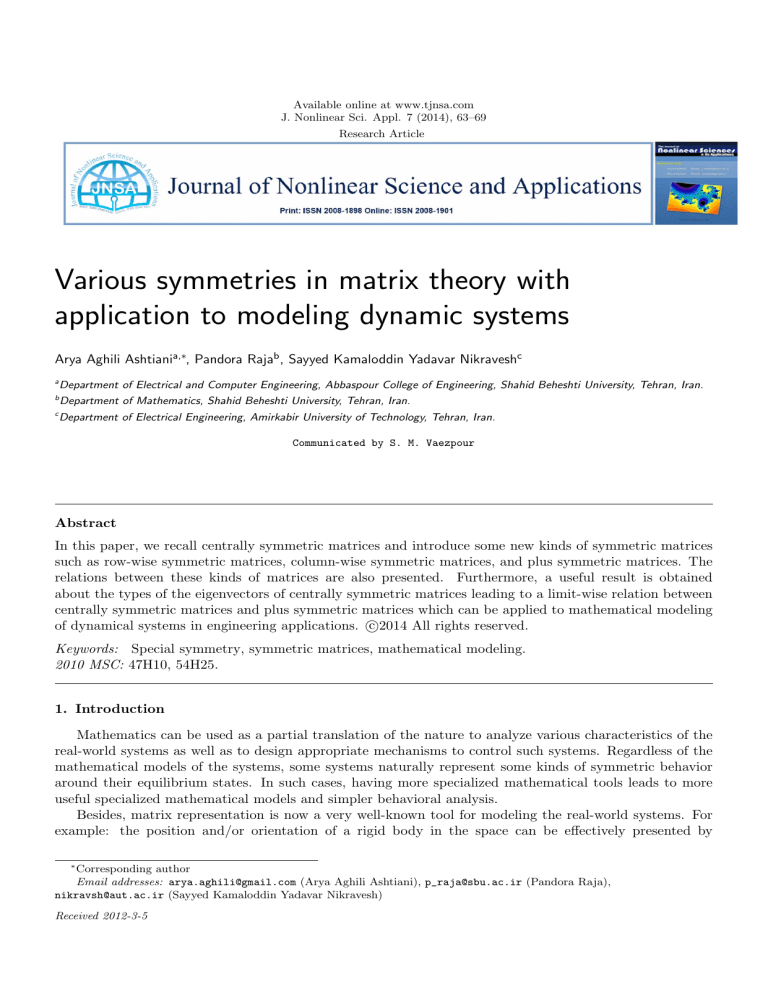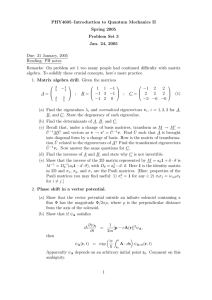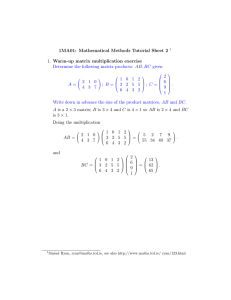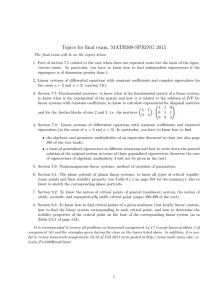
Available online at www.tjnsa.com
J. Nonlinear Sci. Appl. 7 (2014), 63–69
Research Article
Various symmetries in matrix theory with
application to modeling dynamic systems
Arya Aghili Ashtiania,∗, Pandora Rajab , Sayyed Kamaloddin Yadavar Nikraveshc
a
Department of Electrical and Computer Engineering, Abbaspour College of Engineering, Shahid Beheshti University, Tehran, Iran.
b
Department of Mathematics, Shahid Beheshti University, Tehran, Iran.
c
Department of Electrical Engineering, Amirkabir University of Technology, Tehran, Iran.
Communicated by S. M. Vaezpour
Abstract
In this paper, we recall centrally symmetric matrices and introduce some new kinds of symmetric matrices
such as row-wise symmetric matrices, column-wise symmetric matrices, and plus symmetric matrices. The
relations between these kinds of matrices are also presented. Furthermore, a useful result is obtained
about the types of the eigenvectors of centrally symmetric matrices leading to a limit-wise relation between
centrally symmetric matrices and plus symmetric matrices which can be applied to mathematical modeling
of dynamical systems in engineering applications. c 2014 All rights reserved.
Keywords: Special symmetry, symmetric matrices, mathematical modeling.
2010 MSC: 47H10, 54H25.
1. Introduction
Mathematics can be used as a partial translation of the nature to analyze various characteristics of the
real-world systems as well as to design appropriate mechanisms to control such systems. Regardless of the
mathematical models of the systems, some systems naturally represent some kinds of symmetric behavior
around their equilibrium states. In such cases, having more specialized mathematical tools leads to more
useful specialized mathematical models and simpler behavioral analysis.
Besides, matrix representation is now a very well-known tool for modeling the real-world systems. For
example: the position and/or orientation of a rigid body in the space can be effectively presented by
∗
Corresponding author
Email addresses: arya.aghili@gmail.com (Arya Aghili Ashtiani), p_raja@sbu.ac.ir (Pandora Raja),
nikravsh@aut.ac.ir (Sayyed Kamaloddin Yadavar Nikravesh)
Received 2012-3-5
A. Aghili Ashtiani, P. Raja, S. K. Y. Nikravesh, J. Nonlinear Sci. Appl. 7 (2014), 63–69
64
an appropriate matrix; the parameters of an electrical circuit can be gathered in a specific matrix which
represents the relations between the main variables of the circuit; the parameters of an economical system
can be gathered in a specific matrix which describes the behavior of the system; and etc. To be more general,
from a system theoretic view, every dynamic system can be modeled by state space equations which can
be represented by appropriate matrices when the system is linear. This is also true when the system is
nonlinear but can be approximated by a linear transformation. Moreover, the behavior of a completely
nonlinear system can be represented by a matrix in the framework of fuzzy relational modeling, where a
fuzzy relational composition by a fuzzy relational matrix is used to construct the required mapping.
This paper tends to introduce some useful kinds of symmetric matrices and the relations between them.
The results may be used in various applications including the fuzzy relational modeling scheme. In this
regard, in the next section, different kinds of symmetric matrices are defined first and then some of their
characteristics and relations are studied.
Throughout this paper, it is assumed that F is an arbitrary field. Let m, n ∈ N, the ring of all n × n
matrices and the set of all m × n matrices over F be denoted by Mn (F) and Mm×n (F) respectively, and for
simplicity let Fn = Mn×1 (F). The zero matrix is denoted by 0. Also the element of an m × n matrix, R, on
the ith row and jth column is denoted by r(i, j). If A = (aij ) ∈ Mn (F), then [A]ij ∈ M(n−1) (F) is a matrix
obtained by omitting the ith row and the jth column of the matrix A. Also cof(A) ∈ Mn (F) is defined by
cof(A) = aij (−1)i+j det([A]ij ). For more details about the cofactor matrix and the other general algebraic
materials see [5, 9]. For every i, j, 1 6 i, j 6 n, Eij denotes an element in Mn (F) whose entries are all 0
but the (i, j)th entry which is one. Also 0r and Ir denote the zero square matrix of size r and the identity
square matrix of size r respectively. Finally, [x] stands for the integer part of x, for every x in R.
2. Main Results
First, we recall the definition of a centrally symmetric matrix from [8].
Definition 2.1. An m × n matrix R is called centrally symmetric (CS), if
r(i, j) = r(m + 1 − i, n + 1 − j),
for every i, j, 1 6 i 6 m and 1 6 j 6 n.
Centrally symmetric matrices has been introduced since many years ago and various topics about them
have been studied in these years, e.g., calculating their determinants [8] and inverses [4]. Centrally symmetric
matrices have been used in a variety of applications and are still studied by researchers; for example see [7]
and [6] and the references therein.
In [2] some results are obtained about the eigenvectors and eigenvalues of a matrix which is both symmetric and centrally symmetric. In this paper, the results of [2] are extended so that the same results are
achieved with less constraints, i.e., the same characteristics are obtained for the eigenvectors of a matrix
which is only centrally symmetric and not symmetric. These characteristics help finding a limit-wise relation
for centrally symmetric matrices with another kind of symmetric matrices which is introduced in this paper.
In this regard, the new kinds of symmetric matrices are defined as follows.
Definition 2.2. An m × n matrix R is called row-wise symmetric (column-wise symmetric) (RWS/CWS),
if
r(i, j) = r(m + 1 − i, j)
(r(i, j) = r(i, n + 1 − j)),
for every i, j, 1 6 i 6 m and 1 6 j 6 n.
Definition 2.3. An m × n matrix R is called row-wise (column-wise) skew symmetric (RWSS/CWSS), if
r(i, j) = −r(m + 1 − i, j)
for every i, j, 1 6 i 6 m and 1 6 j 6 n.
(r(i, j) = −r(i, n + 1 − j)),
A. Aghili Ashtiani, P. Raja, S. K. Y. Nikravesh, J. Nonlinear Sci. Appl. 7 (2014), 63–69
65
Definition 2.4. An m × n matrix R is called plus symmetric (PS), if it is both RWS matrix and CWS
matrix, or equivalently
r(i, j) = r(m + 1 − i, j) = r(i, n + 1 − j) = r(m + 1 − i, n + 1 − j),
for every i, j, 1 6 i 6 m and 1 6 j 6 n.
Theorem 2.5. Let n ∈ N, and R ∈ Mn (R) be a CS matrix which has n distinct eigenvalues. Then each
of its eigenvectors is either RWS vector or RWSS vector. Furthermore, the number of RWS eigenvectors is
n
n+1
n
[ n+1
2 ] and the number of RWSS eigenvectors is [ 2 ]. (Note that [ 2 ] + [ 2 ] = n).
Proof. Since Aadj(A) = adj(A)A = det(A)I, for every A ∈ Mn (R), thus if λ is an eigenvalue of R, then
(R − λI)adj(R − λI) = det(R − λI)I = 0. Therefore every column of adj(R − λI) is an eigenvector R which
is associated to λ.
Let us write the columns of adj(R − λI) as c1 · · · cn . Now consider a pair of column vectors cj
and cn+1−j , for j, 1 6 j 6 n. Note that R has n distinct eigenvalues and hence rank(adj(R − λI)) = 1, so
cj is proportional to cn+1−j . Since adj(R − λI) = cof(R)T and R is CS, then adj(R − λI) is CS. Therefore
for any value of j, the two vectors cj and cn+1−j are reverse of each other, i.e., one can be obtained by
making the other upside down. Hence the vector cj (and cn+1−j too) is proportional to its reverse and this
may not happen except in two ways:
1. When the vector cj (and also cn+1−j ) is RWS.
2. When the vector cj (and also cn+1−j ) is RWSS.
Therefore each of the eigenvectors of R is either RWS vector or RWSS vector.
For the number of each type of the eigenvectors the proof is as follows. Assume that R = [rij ]. First,
let n = 2m + 1, for some m ∈ N. Suppose that
x = [x1 x2 · · · xm y xm xm−1 · · · x1 ]T
is RWS eigenvector of R. Consider the equation Rx = λx which is equivalent to the following,
CS matrix.
x1
x1
r11
···
r1(m+1)
r1(m+2)
r1(m+3)
···
r1n
..
..
.
.
..
..
..
..
..
..
..
.
.
.
.
.
.
.
xm
xm
.
y
= λ
r(m+1)1 . . r(m+1)(m+1) r(m+1)m r(m+1)(m−1) · · · r(m+1)1
y
xm
xm
..
..
..
..
..
..
..
.
.
.
.
.
.
.
.
..
.
.
.
r1n
···
r1(m+1)
r1m
r1(m−1)
···
r11
x1
x1
Thus
since R is
r11 x1 + r12 x2 + · · · + r1(m+1) y + r1(m+2) xm + · · · + r1n x1 = λx1
..
.
rm1 x1 + rm2 x2 + · · · + rm(m+1) y + rm(m+2) xm + · · · + rmn x1 = λxm
r(m+1)1 x1 + r(m+1)2 x2 + · · · + r(m+1)m xm + r(m+1)(m+1) y + r(m+1)m xm + · · · + r(m+1)1 x1 = λy
rmn x1 + rm(n−1) x2 + · · · + rm(m+2) xm + rm(m+1) y + rmm xm + · · · + rm1 x1 = λxm
..
.
r1n x1 + r1(n−1) x2 + · · · + r1(m+2) xm + r1(m+1) y + r1m xm + · · · + r11 x1 = λx1
A. Aghili Ashtiani, P. Raja, S. K. Y. Nikravesh, J. Nonlinear Sci. Appl. 7 (2014), 63–69
66
An straightforward manipulation shows that the first m equations and the last m equations are the same.
Therefore we have the following set of equations
(r11 + r1n − λ)x1 + (r12 + r1(2m) )x2 + · · · + (r1m + r1(m+1) )xm + r1(m+1) y = 0
..
.
(rm1 + rmn )x1 + (rm2 + rm(2m) )x2 + · · · + (rmm + rm(m+2) − λ)xm + rm(m+1) y = 0
2r(m+1)1 x1 + 2r(m+1)2 x2 + · · · + 2r(m+1)m xm + (r(m+1)(m+1) − λ)y = 0
Since a set of homogenous equations has a non-zero solution if and only if the determinant of the matrix of
its coefficients is equal to zero and the determinant of the matrix of coefficients of the above set of equations
is a polynomial of degree m + 1 of λ and it has at most m + 1 solutions, therefore there are at most m + 1
eigenvalues of R such that their associated eigenvectors are RWS.
Now, Suppose that
x = [x1 x2 · · · xm y − xm − xm−1 · · · − x1 ]T
is a RWSS eigenvector of R. Consider the equation Rx = λx which is equivalent to the following, since R
is CS matrix.
x1
x1
r11
···
r1(m+1)
r1(m+2)
r1(m+3)
···
r1n
..
..
.
.
.
.
.
.
.
.
.
.
.
.
.
.
.
.
.
.
.
.
.
.
.
xm
xm
= λ 0
y
r(m+1)1 . . . r(m+1)(m+1) r(m+1)m r(m+1)(m−1) · · · r(m+1)1
−xm
−xm
..
..
..
..
..
..
..
.
.
.
.
.
.
.
.
..
..
.
r1n
···
r1(m+1)
r1m
r1(m−1)
···
r11
−x1
−x1
Thus
r11 x1 + r12 x2 + · · · + r1m xm + 0 − r1(m+2) xm − · · · − r1n x1 = λx1
..
.
rm1 x1 + rm2 x2 + · · · + rmm xm + 0 − rm(m+2) xm − · · · − rmn x1 = λxm
r(m+1)1 x1 + r(m+1)2 x2 + · · · + r(m+1)m xm + 0 − r(m+1)m xm − · · · − r(m+1)1 x1 = 0
rmn x1 + rm(n−1) x2 + · · · + rm(m+2) xm + 0 − rmm xm − · · · − rm1 x1 = −λxm
..
.
r1n x1 + r1(n−1) x2 + · · · + r1(m+2) xm + 0 − r1m xm − · · · − r11 x1 = −λx1
An straightforward manipulation shows that the first m equations and the last m equations are the same
and the (m + 1)-th equation is trivial. Therefore we have the following set of equations
(r11 − r1n − λ)x1 + (r12 − r1(2m) )x2 + · · · + (r1m − r1(m+1) )xm = 0
..
.
(rm1 − rmn )x1 + (rm2 − rm(2m) )x2 + · · · + (rmm − rm(m+2) − λ)xm = 0
Since a set of homogenous equations has a non-zero solution if and only if the determinant of the matrix of
its coefficients is equal to zero and the determinant of the matrix of coefficients of the above set of equations
is a polynomial of degree m of λ and it has at most m solutions, therefore there are at most m eigenvalues of
R such that their associated eigenvectors are RWSS. Hence the number of RWS eigenvectors is m+1 = [ n+1
2 ]
n
and the number of RWSS eigenvectors is m = [ 2 ], when n = 2m + 1, for some m ∈ N.
If n = 2m, for some m ∈ N, a similar method follows to obtain the result. The proof is completed.
Let R ∈ Mn (R) be a CS matrix. In the next theorem Rk is considered, when k −→ ∞. The limk→∞ Rk
does not necessarily exist but it is interesting that Rk tends towards a PS matrix as k −→ ∞.
A. Aghili Ashtiani, P. Raja, S. K. Y. Nikravesh, J. Nonlinear Sci. Appl. 7 (2014), 63–69
67
Theorem 2.6. Let n ∈ N, and R ∈ Mn (R) be a CS matrix which has n distinct eigenvalues. Then Rk
tends towards a PS matrix if all of the eigenvalues associated with RWSS eigenvectors are located in the unit
circle.
Proof. Let M be the modal matrix of R, i.e., the columns of M are eigenvectors of R. The form of M
is determined according to Theorem 2.5, i.e., all the eigenvectors of R are either RWS or RWSS matrices.
Besides, the relational matrix R can be decomposed as MJM−1 , in which J is a diagonal matrix containing
all the eigenvalues of R. Here just the form of these matrices are important to us. Let’s show M−1 with N
for convenience. The form of N is like that of the transpose of M.
First, suppose that n = 2m, for some m, m ∈ N. An straightforward manipulation shows that
A
B
C
CP
M=
, and N =
,
PA -PB
D -DP
where A, B, C, D, P ∈ Mm (R), and
0
P=
..
.
1
By Theorem 2.5, it can be assumed
eigenvectors are RWS and λm+1 , . . . ,
RWSS. Let k ∈ N and
λ1
S=
0
Thus Jk =
k
Sk 0
0 Tk
1
∈ Mm (R).
0
that λ1 , . . . , λm are the eigenvalues of R such that their associated
λn are the eigenvalues of R such that their associated eigenvectors are
0
..
λm+1
..
and T =
.
λm
0
0
.
.
λn
. Therefore
k
R = MJ N =
ASk C + BTk D
PASk C − PBTk D
ASk CP − BTk DP
PASk CP + PBTk DP
BTk D
−BTk DP
ASk CP
.
+
PASk CP
−PBTk D PBTk DP
ASk C
PASk C
ASk C
ASk CP
Clearly,
is both RWS matrix and CWS matrix, and so it is PS matrix. Also
PASk C PASk CP
BTk D
−BTk DP
by an straightforward manipulation it can be seen that every element of
is a
−PBTk D PBTk DP
polynomial of λkm+1 , . . . , λkn , which by hypothesis tend towards 0 as k −→ ∞. Thus Rk tends towards a PS
matrix.
Next, suppose that n = 2m + 1, for some m ∈ N. In a similar way, it is shown that
A
B
D F
DP
0 , and N =
M= C
,
E
0
-EP
PA -PB
=
where A, DT ∈ Mm×(m+1) (R), B, E ∈ Mm (R), and C, FT ∈ M1×(m+1) (R), and
0
P=
1
..
.
1
∈ Mm (R).
0
A. Aghili Ashtiani, P. Raja, S. K. Y. Nikravesh, J. Nonlinear Sci. Appl. 7 (2014), 63–69
68
By Theorem 2.5, we may assume that λ1 , . . . , λm+1 are the eigenvalues of R such that their associated
eigenvectors are RWS and λm+2 , . . . , λn are the eigenvalues of R such that their associated eigenvectors are
RWSS. Let k ∈ N and
λ1
0
λm+2
0
..
..
S=
and T =
.
.
.
0
Thus Jk =
Sk 0
0 Tk
λm+1
0
λn
. Therefore
ASk D + BTk E
ASk F
ASk DP − BTk EP
Rk = MJk N =
CSk D
CSk F
CSk DP
k
k
k
k
k
PAS D − PBT E
PAS F
PAS DP + PBT EP
ASk D
ASk F
ASk DP
BTk E
0 −BTk EP
.
0
0
0
= CSk D
CSk F
CSk DP +
k
k
k
k
k
−PBT E 0 PBT EP
PAS D PAS F PAS DP
ASk D
ASk F
ASk DP
k
k
Clearly, CS D
CS F
CSk DP is both RWS matrix and CWS matrix, and so it is PS matrix.
PASk D PASk F PASk DP
BTk E
0 −BTk EP
0
0
0
Also by an straightforward manipulation it can be seen that every element of
k
k
−PBT E 0 PBT EP
is a polynomial of λkm+2 , . . . , λkn , which by hypothesis tend towards 0 as k −→ ∞. Thus Rk tends towards
a PS matrix. This competes the proof.
Each kind of the symmetric matrices introduced in this paper, may be seen in many types of mathematical models, where a matrix representation is used to store the parameters of the model. The inputs of
such models are usually processed through compositions with matrices under a matrix equation. Therefore,
solving a matrix equation for a special kind of symmetric matrix becomes important as the applications
grow. See [11] and [10] for example, where some methods are proposed respectively for analytical and numerical solution of algebraic matrix equations for centrally symmetric matrices. Algebraic matrix equations
may be used as state equations to construct discrete-time state-space models leading to a very important
modeling framework in system theory which can be used for modeling linear dynamical systems or linear
approximations of nonlinear dynamical systems [3]. As another important example, the proposed symmetric
matrices may be used as the fuzzy relational matrix in the fuzzy relational modeling framework, where the
model is ruled by a fuzzy relational equation [1]. State-space models and fuzzy relational models, both can
be used to model discrete-time dynamical systems. Theorem 2.6 may be used to study the convergence of
the output of a model in which the involving matrix is centrally symmetric as time goes by.
It is worth mentioning that the dynamic behavior of the system might be exactly or approximately
symmetric about an operating point which is very common in practical cases specially in a local view.
A well-known benchmark example in control theory is the behavior of an inverted pendulum around its
upward or downward position. Likewise, consider a dynamic system which has a symmetric behavior about
its unique equilibrium point. In such cases, the system may be modeled by a fuzzy relational model with
a centrally symmetric relational matrix in which the center of the membership functions are distributed
symmetrically about the origin and so the convergence of the output to the origin can be achieved.
References
[1] A. Aghili Ashtiani and M. B. Menhaj, Numerical Solution of Fuzzy Relational Equations Based on Smooth Fuzzy
Norms, Soft Computing, 14 (2010), 545–557. 2
A. Aghili Ashtiani, P. Raja, S. K. Y. Nikravesh, J. Nonlinear Sci. Appl. 7 (2014), 63–69
69
[2] A. Cantoni, P. Butler, Elgenvalues and Elgenvectors of Symmetric Centrosymmetrlc Matrlces, Linear Algebra
Appl., 13 (1976), 275–288. 2
[3] C.T. Chen, Linear System Theory and Design, 4th Ed., Oxford University Press (2012).
[4] I. J. Good, The Inverse of a Centrosymmetric Matrix, Technometrics 12 (1970), 925–928.
[5] K. Hoffman, R. Kunze, Linear Algebra, second ed., Prentice-Hall, Inc., (1971). 2
[6] L. Lebtahi, O. Romero, N. Thome, Relations Between {K, s + 1}-potent matrices and Different Classes of Complex
Matrices, Linear Algebra Appl., 438 (2013), 1517–1531. 1
[7] H. Li, D. Zhao, F. Dai, D. Su, On the spectral radius of a nonnegative centrosymmetric matrix, Appl. Math.
Comput., 218 (2012), 4962–4966. 2
[8] T. Muir, A Treatise on the Theory of Determinants, Dover (1960) (originally published 1883). 2
[9] V. V. Prasolov, Problems and Theorems in Linear Algebra, Translations of Mathematical Monographs, No. 134,
(1994). 2, 2
[10] Z. Tian, C. Gu, The Iterative Methods for Centrosymmetric Matrices, Appl. Math. Comput., 187 (2007), 902–911.
1
[11] F.Z. Zhou, L. Zhang, X.Y. Hu, Least-Square Solutions for Inverse Problems of Centrosymmetric Matrices, Computers and Mathematics with Applications, 45 (2003), 1581–1589. 2
2









